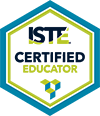Be a Google Guru: 50 Tips and Tricks for Educators
,
Colorado Convention Center, 203
Presenters


Session description
Purpose & objective
This presentation's goal is to equip teachers with the information, abilities, and useful strategies they need to successfully integrate Google Workspace and its related products into their classrooms. Participants will be able to improve their classroom instruction, maximize efficiency, and promote collaboration by learning about innovative applications and hidden capabilities inside Google Docs, Drive, Forms, Sheets, Classroom, and more. Through the use of Google Tools, the presentation seeks to address the pedagogical problem of adjusting to a technologically enhanced classroom. It isn't just about showing how to use a digital tool, but different ways the tools can be used within the classroom.
The educational challenge that will be addressed involves educators who have developed a habitual approach to using digital tools, often sticking to familiar routines and student activities. Many teachers learn the basics of a digital tool, but are not sure how to implement those tools within the classroom. To overcome this challenge, educators require fresh perspectives and practical guidance to explore new and innovative ways of utilizing digital tools within their learning environments.
To solve the educational problem Google Workspace, including Google Docs, Drive, Forms, Sheets, Slides, Sites, Classroom will be explored in innovative and inspirational ways they can be implemented within the classroom as well as showing numerous hidden features and hints of each tool will be introduced and explored during this presentation.
Participants will gain insights into Google Tools through examples and demonstrations, enhancing their classroom use of Google Workspace tools. The presentation includes interactive templates and pre-designed activities for hands-on application across diverse subjects. Additionally, we'll uncover hidden features and offer real-time tips within the tools, ensuring practical, immediate learning.
Success will be evident in improved teaching practices, increased collaboration, and enhanced learning outcomes for students. The intent is for teachers to take the plethora of different ideas and strategies and apply a few within their own classrooms and more over time.
Outline
For the 60 minute time frame will roughly following this framework.
Introduction (2 minutes)
Humorously introduce myself. Explain the outline of how the presentation is structured.
Google Docs (10 minutes)
Showcase different ways teachers can use Google Docs including Student Choice Boards and hyperdocs. Tracking the writing processes using Version History, docs drop-downs for collaborative notetaking, research papers using the citations and explore tools. Share a some "Did you know?" tips, including "docs.new" and opening an image with docs to automatically convert images to text.
Google Drive (10 minutes)
Briefly discuss effective file organization using Google Drive including color-coding folders, naming conventions and emojis, discussing how this can benefit both teachers and students.
Google Forms (10 minutes)
Present different ways to use Google Forms within the classroom including for creating Classroom Quizzes, student created rubrics, writing narratives with branching forms, and used forms for collecting parent documentation. Share a "Did you know?" tip about adding in videos and gathering data.
Google Slides (10 minutes)
Showcase using Google Slides in the classroom by creating Bitmoji Classrooms, creating student self-paced instructional menus as well as student created apps for lesson activities. Google Slides templates can be used for digital note booking and data binders. Demonstrate how slides can be used to gamify instruction and how student can create projects like stop motion videos.
Google Sites (5 minutes)
Discuss Google Sites for teacher portfolios, classroom websites and digital information hubs. Share a single "Did you know?" tip, like embedding Google Apps or checking different links with incognito windows to check share permissions.
Google Chrome (5 minutes)
- Highlight with teachers how to customize Google Chrome with themes to differentiate between work and personal accounts as well as different teacher specific extensions. Share tab organization and shortcut keys. Share some quick Google Chrome AI features.
Google Classroom (5 minutes)
Discuss key uses of different Google Classrooms, such as using Classroom for book clubs, flipped classrooms and for early finisher activities. Share one Classroom management tip like creating topics emojis or assignment naming conventions.
Q&A and Conclusion (5 minutes)
Answer questions. Summarize key takeaways and encourage participants to explore the shared resources.
Supporting research
This article was an article I learned about become an Iste certified Educator. https://cdn.iste.org/www-root/PDF/advocacy-pages/Making%20the%20Case%20for%20the%20ISTE%20Standards.pdf. The article emphasizes not just using the digital tool, but instead using the tool for specific purposes and empowering students to have a voice and choice in their learning.
This article discusses how post COVID 19 instructional practices need to change- https://www.sciencedirect.com/science/article/pii/S2666412722000137. This includes the idea that time-consuming and repetitive assignments can be replaced by strategic digital activities. This also ties into environmental and ecological concerns.
This article shares ways technology can be shared and integrated within th classroom- https://drexel.edu/soe/resources/student-teaching/advice/how-to-use-technology-in-the-classroom/#:~:text=Integration%20of%20technology%20in%20education,actively%20engaged%20with%20learning%20objectives. Technology integration is important because it can keep students engaged while also preparing students with life skills.
Session specifications
Learner
- Set professional learning goals to explore and apply pedagogical approaches made possible by technology and reflect on their effectiveness.
- Model for colleagues the identification, exploration, evaluation, curation and adoption of new digital resources and tools for learning.
Empowered Learner
- Students understand the fundamental concepts of technology operations, demonstrate the ability to choose, use and troubleshoot current technologies and are able to transfer their knowledge to explore emerging technologies.
 Return
Return Listen and learn: Edtalk
Listen and learn: Edtalk  Trips and Tours
Trips and Tours Streaming Session
Streaming Session Recorded Session
Recorded Session